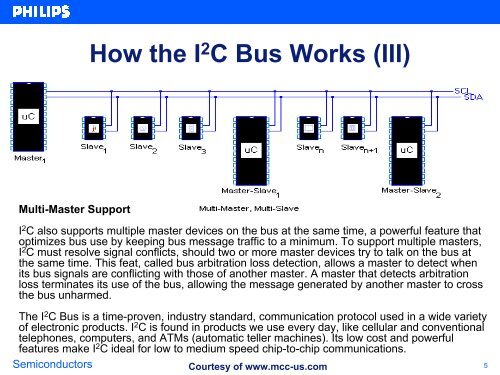How the I2C Bus Works - EEWeb
How the I2C Bus Works - EEWeb
How the I2C Bus Works - EEWeb
Create successful ePaper yourself
Turn your PDF publications into a flip-book with our unique Google optimized e-Paper software.
Multi-Master Support<br />
<strong>How</strong> <strong>the</strong> I 2 C <strong>Bus</strong> <strong>Works</strong> (III)<br />
I 2 C also supports multiple master devices on <strong>the</strong> bus at <strong>the</strong> same time, a powerful feature that<br />
optimizes bus use by keeping bus message traffic to a minimum. To support multiple masters,<br />
I 2 C must resolve signal conflicts, should two or more master devices try to talk on <strong>the</strong> bus at<br />
<strong>the</strong> same time. This feat, called bus arbitration loss detection, allows a master to detect when<br />
its bus signals are conflicting with those of ano<strong>the</strong>r master. A master that detects arbitration<br />
loss terminates its use of <strong>the</strong> bus, allowing <strong>the</strong> message generated by ano<strong>the</strong>r master to cross<br />
<strong>the</strong> bus unharmed.<br />
The <strong>I2C</strong> <strong>Bus</strong> is a time-proven, industry standard, communication protocol used in a wide variety<br />
of electronic products. <strong>I2C</strong> is found in products we use every day, like cellular and conventional<br />
telephones, computers, and ATMs (automatic teller machines). Its low cost and powerful<br />
features make <strong>I2C</strong> ideal for low to medium speed chip-to-chip communications.<br />
Semiconductors 5<br />
Courtesy of www.mcc-us.com















